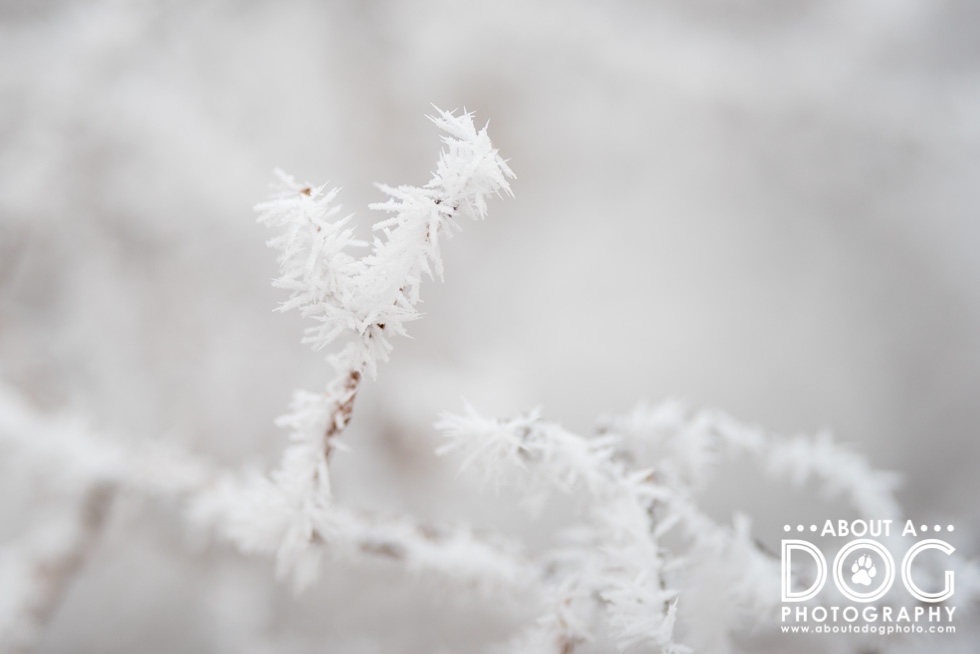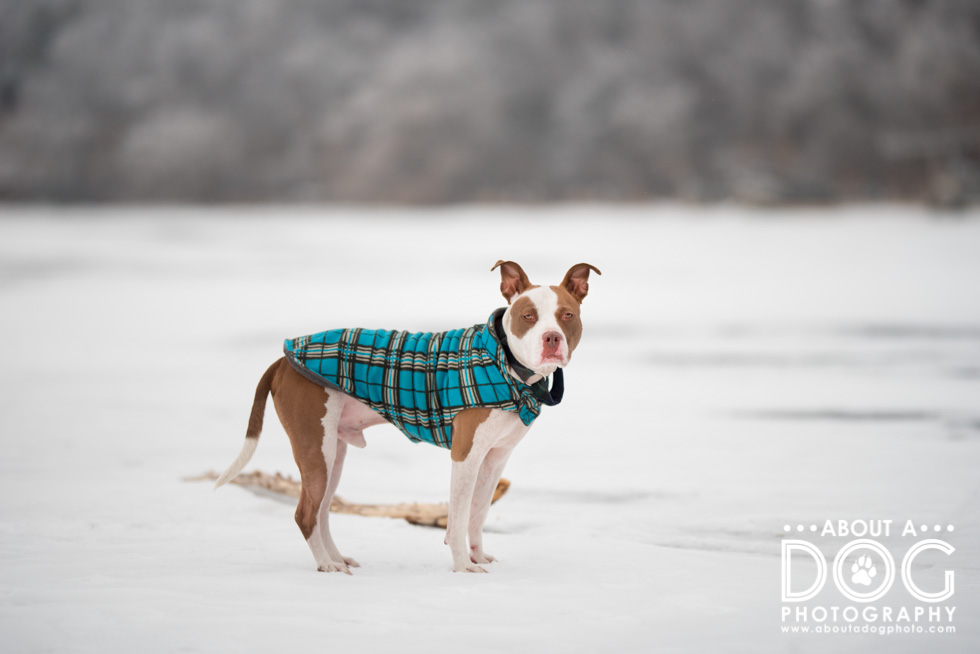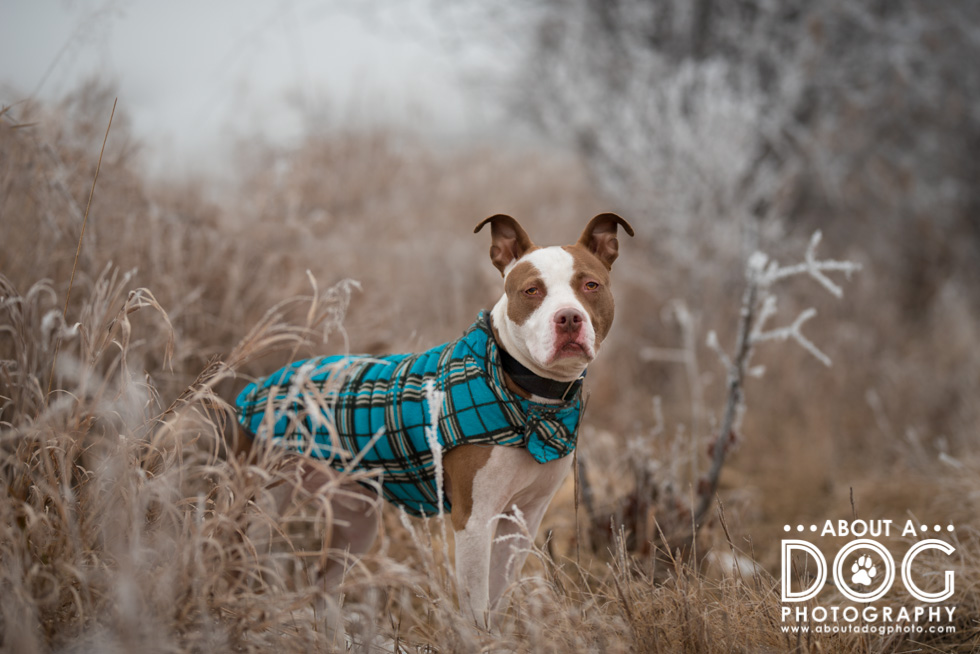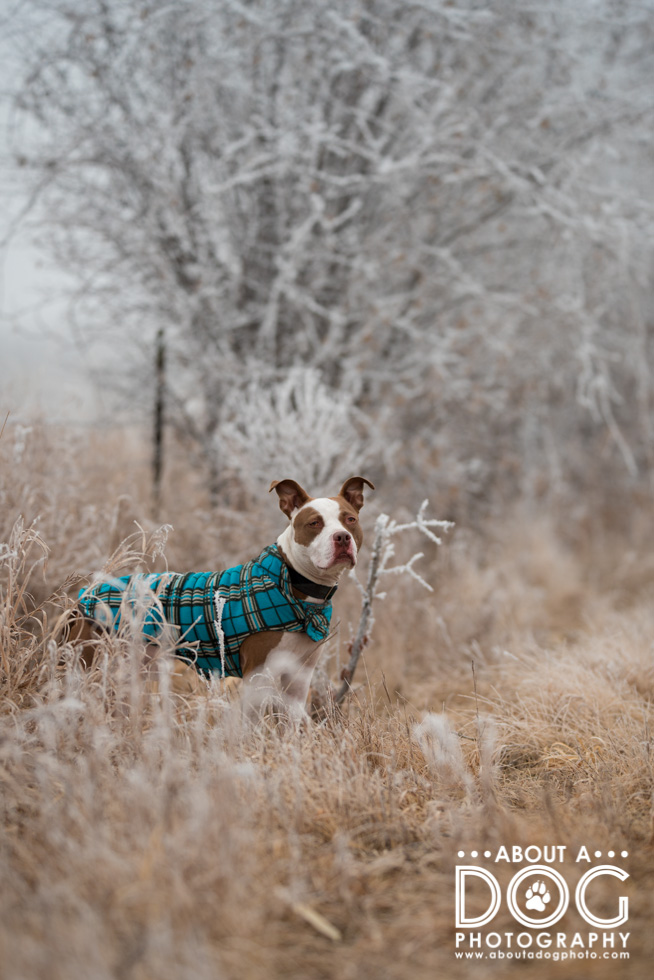The 52 Week Project is a blog circle with a theme for every week (which means we all link to each other, links are found at the end of the post).
Depth of field was the theme for this week’s 52 Week Project. Depth of field is the blur (good blur) in an image. It can be narrow and isolate subjects (as in portraits) or it can be deep to include more of the scene in focus (as in landscapes).
The easiest way to adjust depth of field is aperture. Using a WIDE open aperture (f/1.8, f/2.8) will make the depth of field narrower (= more blur & subject isolation), while a stopped down NARROWER aperture (f/8 etc) will make the depth of field deeper ( = less blur, less subject isolation). Additionally a NARROWER aperture will let in less light, which means there is the possibility of capturing motion blur if your shutter isn’t fast enough.
(Aperture isn’t the only thing to affect depth of field…)
A beautiful thick hoarfrost greeted Bender and I in the morning.

We rushed to the lake in the hopes that the small patch of woods was going to be sporting the hairy white frost. The woods had little to none. A gawk at the lake showed stunning hoarfrost on the trees along the shoreline. The lake was flat, crisp white, crunching slightly under foot as we walked farther out onto the lake.
Bender doesn’t like the cold and holds a sit/stay very loosely which makes it a challenge to use the 135mm with him. Luckily, a random branch of driftwood had been frozen to the surface of the lake and acted like the perfect hitching spot for Bender. (He’s also rocking his new Pack Leash! Want one of your own? Use jointhepack for 15% off your purchase! Plus Pack will donate 4 lbs of dog food to rescues!)
Wide aperture at f/1.8 = lots of blur/narrow depth of field.

The difference of a narrow depth of field (f/2) and a deep depth of field (f/8). Notice how the trees start to become more crisp and defined at f/8 and you can see the fish houses that are just off shore.
[twenty20 img1=”10917″ img2=”10918″ offset=”.8″]
[twenty20 img1=”10915″ img2=”10914″ offset=”0.7″]
I do prefer the look of the narrow depth of field that makes a subject pop off of a scene. Huzzah for subject isolation! (Below is f/1.8).

The look of the hoarfrost wasn’t quite what I wanted so we adventured away from the lake to a quaint back road just down from a Charolais cattle farm. The grasses and bushes were the perfect backdrop with their fuzzy hoarfrost and golden color.

The difference of f/2 to f/8. Since Bender is closer to the background, its easier to see how the depth of field gets deeper and the subject isolation is lost with the bushes and grasses. You can also see the pole of the barbed wire fence he was leashed to.

[twenty20 img1=”10923″ img2=”10922″ offset=”0.7″]

Did you know the focal length of a lens also affects depth of field?
In the regards of depth of field, wide angle lenses (wider field of view than 50mm) will naturally have a deeper depth of field than a telephoto lens (narrower field of view than 70mm) even at the same settings. This is mostly due to some elaborate math and the magnification/compression that happens with a telephoto lens.
Want more blur aka a narrower depth of field? Reach for your telephoto lens!
** Also look at the quality of the blur – wide angle lenses have “sparkly” blur while telephoto lenses have a “smooth” blur. **
Additionally, the closer you are to a subject the narrower your depth of field will be. Which is why I can still achieve narrow depth of field with my 20mm lens. I’m literally thisclose to my subject (which Bender thinks is annoying and gives me the bald old earless man look). Closer to your subject = narrower depth of field. Farther is the reverse affect.
20mm at f/1.8.
On the right a comparison of f/2 and f/7.1. Due to Bender being closer to the bushes & grasses, they are more in focus at f/7.1 than the trees on the lake at f/8.

[twenty20 img1=”10925″ img2=”10926″ offset=”0.7″]
Whew! That was quite the bantering about depth of field! Next visit Elaine Tweedy, I Got The Shot Photography, Northeast PA Pet Photographer to learn about her take on depth of field.

Such variety in your images, what a great way to demonstrate depth of field, especially with the slider tool! Bender is adorbs!
Loved your examples, and the slider tool, and, of course, Bender!
I love your use of the slider. I am going to have to figure out how to do that!
Love those sliders! Great examples and comparisons. It looks very cold where you are. Bender did a great job modelling, especially in that coat!
Bender was a super model for you! Nicely done!
Beautiful examples and I love that coat! 😀
Great job! Love your photos – no ‘socks’ for the feet?
Great info and examples!! What a gorgeous model and location!
Yes, I love your sliders. Beautifully executed shots and description.
Awesome job using the sliders to show the difference in DOF in your images. Love that!
Fantastic use of sliders to show the difference between apertures! Great photos.